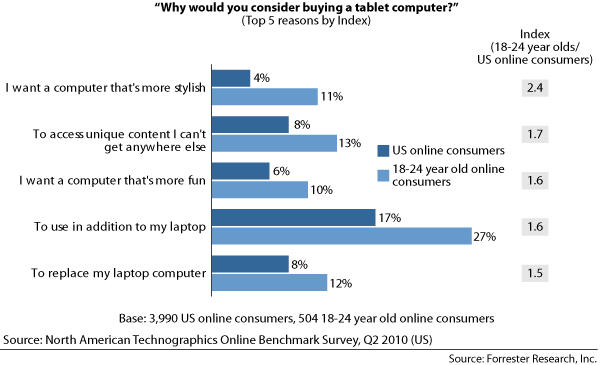The Data Digest: Why Young Consumers Like Tablets
With tablet sales projected to grow from 10.3 million in 2010 to 44 million in 2015, we wanted to understand what will be fueling this growth. Since 18- to 24-year-olds will be the ones growing up accustomed to this technology, we honed in on this demographic to see what it is about the tablets that excites them the most. Our Technographics® data shows that they want a tablet for a variety of reasons, but what they are most attracted to is its portability, and they are much more driven than US online consumers in general by its “fun factor.”

- Portability for relaxation. Compared with online adults, 18- to 24-year-olds are more likely to want a lighter device that’s more convenient for viewing/reading while relaxing. One in four thinks laptops are just too heavy to carry around all the time. Shopping sites such as eBay and Gilt Groupe have capitalized on this insight by developing apps that amplify users’ browsing experience by enlarging the pictures, enhancing zoom features, and allowing users to easily drag and drop items.
- The fun factor: Young online consumers are 1.75 times more likely than general online consumers to want to access unique content, and one in 10 admits that he or she wants a computer that’s more fun. Apple has done a great job of promoting the “awe factor” that comes along with practical each use of the tablet. These consumers are entertainment-driven when it comes to their use of the Internet. According to our North American Technographics Online Benchmark Survey, Q2 2010 (US), almost one in two 18- to 24-year-olds use the Internet to play games alone, listen to audio/radio, and watch full-length TV shows. Other tablet manufacturers that want to appeal to young consumers must either build or support a platform around entertainment apps, as this will be key for winning them over.
It is clear that the tablet presents great opportunities for marketers to expand their multichannel interaction with consumers. However, before jumping on the bandwagon, brands need to understand the behavioral nuances of different age groups in order to keep applications relevant to their target segments.